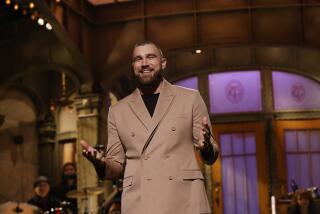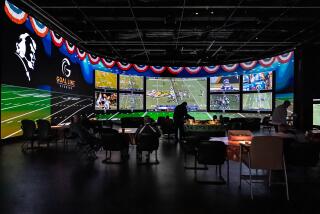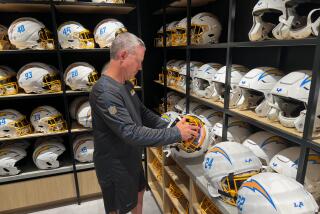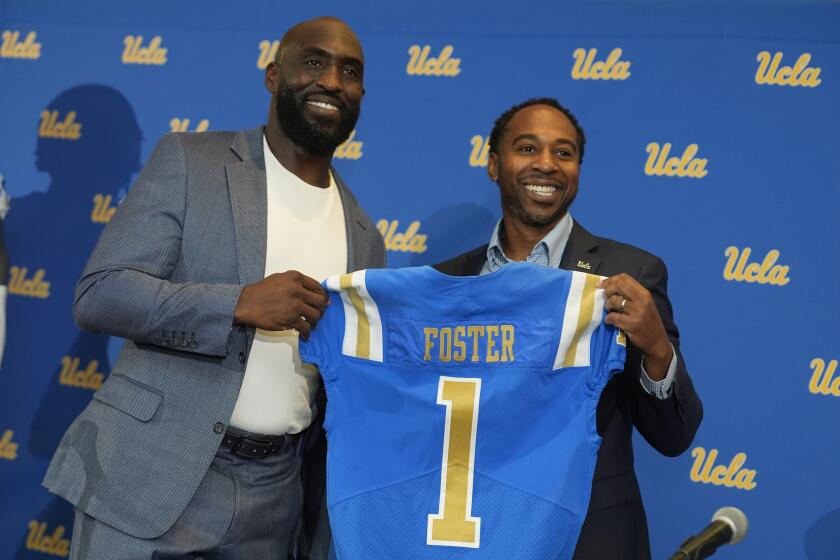Tom House gets calls from quarterbacks
Tom House spent eight years in the majors as a relief pitcher, but he is best remembered for catching Hank Aaron’s record-breaking 715th home run. The ball sailed over the fence and into the bullpen, and House ran under it.
Now, almost four decades later from his modest digs at USC, House is helping future Hall of Famers go deep.
Guys like New England’s Tom Brady and New Orleans’ Drew Brees.
That’s right, two of the best quarterbacks in NFL history have turned to a former pitcher — one who pays precious little attention to pro football — to help fine-tune their skills. Both spent time at USC this off-season.
And they aren’t the only ones. San Francisco’s Alex Smith has worked with House too, as have Baltimore’s Joe Flacco, Kansas City’s Matt Cassel, Oakland’s Carson Palmer, and even a certain second-string quarterback for the New York Jets.
“Tim Tebow called out of nowhere and said, ‘Hey, whatever you’re doing, I want to know what it is,’” said House, 65, who was able to work with the Jets star without creating too much of a stir.
“We closed the gates, and we just worked with whoever he brought with him to watch. He didn’t want autographs or cameras. There was a baseball thing going on, and some of the people had their cameras. He politely said, ‘Can you tell them not to film me?’ He didn’t want to see himself on YouTube and Facebook.”
An expert in motion analysis, House doesn’t try to instruct a quarterback what to do with his hands or feet, but focuses on the turning of the hips and shoulders, and how to transfer that energy to the football. Imagine the body as a whip; House shows athletes how best to crack it.
“We don’t make adjustments,” he said. “We make suggestions.”
Breaking down the mechanics of throwing is one element of House’s entire coaching package. He also works with athletes on their conditioning, their mental and emotional outlook, and their nutrition.
House and his fellow analysts study a quarterback by looking for irregularities and inefficiencies in what appear to be crude stick figures of the athlete in motion. Those figures are actually three-dimensional renderings generated by a system of eight high-speed cameras positioned at various angles, and simultaneously shooting light-sensitive dots affixed to the athlete. A computer then connects the dots and forms a stick figure that, for example, shows the quarterback’s head is tilted too far to one side when he’s releasing the ball.
“I get a little intimidated when some of these guys show up, because what am I going to show Tom Brady about mechanics?” House said. “So with him I waited until we actually got the analysis, where it’s not my eyes, not my opinion, here it is at 1,000 frames per second. ‘This is what you’re doing efficiently and inefficiently.’”
Brees describes House as “a mentor,” and presented him with a Saints game jersey, now framed in the coach’s office above Dedeaux Field.
Said Brees: “He’ll watch everything: ‘Let’s work on that off hand and keep that tight to the body. Let’s work on that hip and shoulder disassociation.’ He’ll give me these observations and things to work on. It’s kind of fine-tuning.”
Brady met the throwing specialist this spring and took instruction from House and his staff at USC this summer — including having House come to Foxborough, Mass., in August for joint workouts involving the Saints and Patriots.
“Tom says when you pass a certain age, you’ve really got to learn to re-learn,” Brady said. “A lot of it’s re-learning different things that maybe you’ve done and have become habits that you’ve done thousands and thousands of times, that you really need to train yourself a different way to improve certain aspects of your mechanics.”
Just as Tiger Woods tinkered with his swing, even at the height of his game, the elite quarterbacks are always looking for the slightest advantage, the feather that tips the scales.
“Guys are just looking for that half-percent, and that just might be the difference,” said Charlie Nootbaar, who works with House at the nonprofit Rod Dedeaux Research and Baseball Institute and the for-profit National Pitching Assn. “That’s what separates the elite guys. They’re always looking for that half-percent.”
Still surprising to House is how quickly NFL quarterbacks can see a problem with their motion and make a physical adjustment to fix it. Typically, he said, they do that much more quickly than baseball players.
“Their ability to process information is almost instantaneous,” he said. “Pitchers, on the other hand, you’re talking a month, two months, sometimes five or six months. I think it’s because pitchers have all the time in the world. Quarterbacks don’t. Quarterbacks have to process a whole bunch of stuff in a really small amount of time, and turn it into action.
“They’re like jet pilots. They can get the whole picture, and they can make that picture slow down in their mind to whatever speed they want.”
House and his staff don’t just work with quarterbacks. They work with so-called rotational athletes, whose sport requires them to generate energy by turning their torsos, whether it’s throwing a pitch or a football, swinging a golf club, or smacking a tennis ball.
This week, intermingled with baseball players and golfers, were former NFL quarterback J.P. Losman, and Arena League quarterback Luke Collis. When Brady was working out at USC, he brought along Patriots tight end Aaron Hernandez and receiver Julian Edelman.
House said that Brady, rather than acting like a superstar, fit right into the group. In fact, he bonded most closely with a 14-year-old baseball player, the two exchanging fist-bumps at every triumph.
Said Brady, a two-time NFL most valuable player: “The commonality with it is you’re there with a lot of guys that are trying to get better, more so than, ‘Look, this is what I’ve done.’ Everyone is really humble enough to realize that they don’t have all the answers, and they want to seek a better way. To me, the guys who are self-confident are the ones that are always trying to find ways to improve.”
House played baseball at USC, and later in the majors with Atlanta, Boston and Seattle. After retiring as a player, he was a pitching coach in the majors, working with such notable names as Nolan Ryan, Randy Johnson, Robb Nen and Kevin Brown.
House settled in Del Mar, where he got to know Cam Cameron, then offensive coordinator of the San Diego Chargers. Cameron introduced him to Brees in 2004, and House began working with the third-year quarterback.
A few years later, when Cameron was in his current role as Baltimore’s offensive coordinator, he sent a young Flacco to work with House. Word spread, and suddenly House was getting calls from all over the league. He declined to say how much he charges players for the service.
“I was amazed at how the jungle drums worked,” House said. “Quarterbacks talk among themselves. When they find something they feel works, they share it.”
twitter.com/LATimesfarmer
More to Read
Go beyond the scoreboard
Get the latest on L.A.'s teams in the daily Sports Report newsletter.
You may occasionally receive promotional content from the Los Angeles Times.











